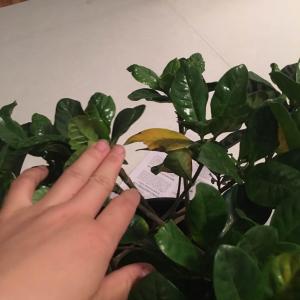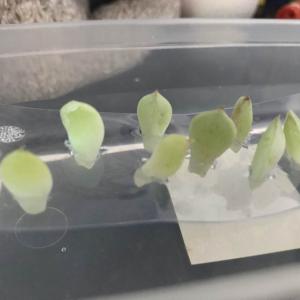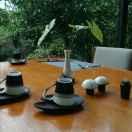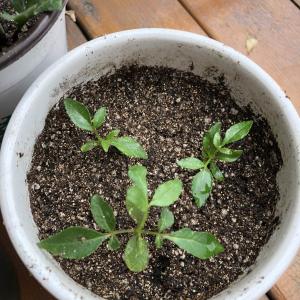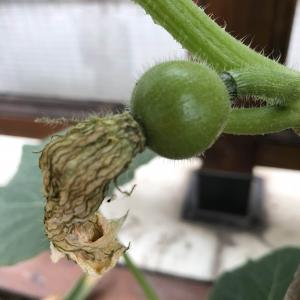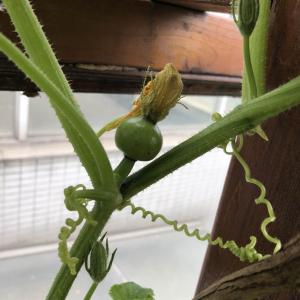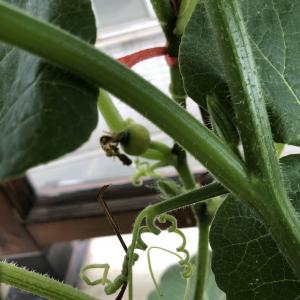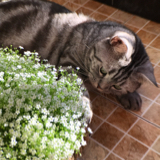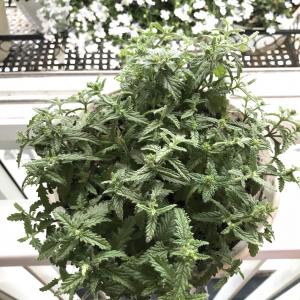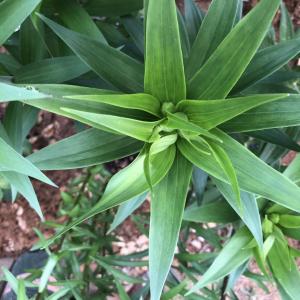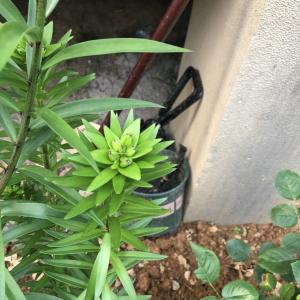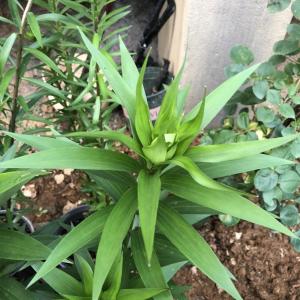文章
Miss Chen
2018年05月20日

Description: This biennial plant is 1-2' tall, branching occasionally. The stems are light green, terete, and covered with spreading hairs; these hairs are often glandular. The alternate leaves are simple-pinnate; they are usually divided into 3-5 leaflets (rarely 7). The leaf blades are up to 5" long and 3" across; the petioles of these leaves become shorter as they ascend the stems. The leaflets of each blade are ovate, broadly ovate, oblong, or oblanceolate in shape; they are shallowly to deeply cleft and bluntly dentate along their margins. Often, the terminal leaflets are more deeply cleft than the lateral leaflets. Both leaf blades and petioles are more or less hairy. The upper surfaces of mature blades are medium to dark green; however, theClose-up of Flower earliest leaf-blades of the year have upper surfaces with silver-grey blotches. The upper stems terminate in racemes of 4-12 flowers; often there are a few secondary racemes that develop from the axils of the upper leaves. Buds and flowers are typically concentrated toward the apex of each raceme, while the developing fruits are located below on spreading pedicels. These pedicels are glandular-hairy and about ½" long. Each flower is about ½" across when it is in bloom; it consists of a 5-lobed corolla, a calyx with 5 sepals, 5 stamens, a slender style, and an ovary. The corolla can vary in color from pale lavender to deep blue-violet. The green sepals are linear-lanceolate and hairy; they become recurved during and after the blooming period. The style of each flower divides into 2 parts toward the middle of its length, while the stamens have finely hairy filaments and brownish anthers. The blooming period occurs during the late spring and lasts about a month. Each flower is replaced by an ovoid seed capsule that divides into 2 parts to release its seeds. This plant reproduces by reseeding itself.
Cultivation: The preference is dappled sunlight to light shade, moist conditions, and a rather rich loam or silt-loam containing organic matter. After the flowering period, more shade from canopy trees is tolerated because this plant dies down. While this plant doesn't grow on rocks like some ferns, it tolerates soil that is somewhat thin and rocky from underlying bedrock if there is enough moisture.
Range & Habitat: The native Forest Phacelia occurs occasionally in the southern half of Illinois, while in the northern half of the state it is rare or absent (see Distribution Map). Habitats include moist areas of deciduous woodlands and rocky woodlands, rocky banks and low areas along woodland streams, moist depressions of bluffs, bottoms of sandstone canyons, and lower slopes of ravines. This wildflower is typically found in various moist areas of rocky woodlands.
Faunal Associations: The nectar and pollen of the flowers attract primarily bees (long-tongued & short-tongued); less common floral visitors include butterflies, skippers, and wasps. The foliage of Phacelia spp. (Phacelias) is eaten by the the oligophagous Scelolyperus wilcoxi (Skeletonizing Leaf Beetle sp.). Information about the edibility of the foliage to mammalian herbivores is unavailable.

Photographic Location: The bottom of a sandstone canyon along a woodland stream at the Portland Arch in west-central Indiana.
Comments: Forest Phacelia is another lovely woodland wildflower in the Waterleaf family. This species and other Phacelia spp. (Phacelias) are closely related to the Hydrophyllum spp. (Waterleaf species), which also occur in woodlands and bloom at about the same time. Among the species in Illinois, the style of a Phacelia is divided toward the middle of its length, while the style of a Waterleaf is divided toward its apex; this is the easiest way to distinguish these two groups of very similar wildflowers. Compared to other Phacelias in Illinois, Forest Phacelia usually has larger flowers (about ½" across, if not more) and the lobes of its corollas are smooth, rather than conspicuously fringed. Some species of Waterleaf are similar to it, but they lack tripartite leaves or the lobes of their corollas are less widely spreading when the flowers are blooming. If all else fails, they can be distinguished by their styles, as described above. Another common of Phacelia bipinnatifida is Loose-Flowered Phacelia.
Cultivation: The preference is dappled sunlight to light shade, moist conditions, and a rather rich loam or silt-loam containing organic matter. After the flowering period, more shade from canopy trees is tolerated because this plant dies down. While this plant doesn't grow on rocks like some ferns, it tolerates soil that is somewhat thin and rocky from underlying bedrock if there is enough moisture.
Range & Habitat: The native Forest Phacelia occurs occasionally in the southern half of Illinois, while in the northern half of the state it is rare or absent (see Distribution Map). Habitats include moist areas of deciduous woodlands and rocky woodlands, rocky banks and low areas along woodland streams, moist depressions of bluffs, bottoms of sandstone canyons, and lower slopes of ravines. This wildflower is typically found in various moist areas of rocky woodlands.
Faunal Associations: The nectar and pollen of the flowers attract primarily bees (long-tongued & short-tongued); less common floral visitors include butterflies, skippers, and wasps. The foliage of Phacelia spp. (Phacelias) is eaten by the the oligophagous Scelolyperus wilcoxi (Skeletonizing Leaf Beetle sp.). Information about the edibility of the foliage to mammalian herbivores is unavailable.

Photographic Location: The bottom of a sandstone canyon along a woodland stream at the Portland Arch in west-central Indiana.
Comments: Forest Phacelia is another lovely woodland wildflower in the Waterleaf family. This species and other Phacelia spp. (Phacelias) are closely related to the Hydrophyllum spp. (Waterleaf species), which also occur in woodlands and bloom at about the same time. Among the species in Illinois, the style of a Phacelia is divided toward the middle of its length, while the style of a Waterleaf is divided toward its apex; this is the easiest way to distinguish these two groups of very similar wildflowers. Compared to other Phacelias in Illinois, Forest Phacelia usually has larger flowers (about ½" across, if not more) and the lobes of its corollas are smooth, rather than conspicuously fringed. Some species of Waterleaf are similar to it, but they lack tripartite leaves or the lobes of their corollas are less widely spreading when the flowers are blooming. If all else fails, they can be distinguished by their styles, as described above. Another common of Phacelia bipinnatifida is Loose-Flowered Phacelia.
0
1
文章
Miss Chen
2018年05月20日

Description: This perennial wildflower is 3-8" tall. It has an unbranched stem that terminates in a whorl of compound leaves and a single flowering stalk. The central stem is light green to dull red and hairless. The compound leaves are palmate with 3-5 leaflets. Individual leaflets are ¾-1½" long and about one-third as much across; they are oblanceolate or elliptic, serrated along their margins, and sessile (or nearly so). The upper surface of the leaves is medium green and hairless. The petioles of the compound leaves are ¾-2" long, light green to dull red, and hairless. The flowering stalk rises 1-3" above the leaves, terminating in a small umbel of white flowers about ¾" across. Like the central stem, it is light green to dull red and hairless. Individual flowers are about 1/8" (3 mm.) across, consisting of 5 white petals, a short white calyx, and 5 white stamens. The flowers of some plants are all staminate (male), while the flowers of other plants are perfect (male & female). Each staminate flower has a single non-functional style, while each perfect flower has 3 styles and a 3-celled ovary. Individual plants are capable of changing their gender from year-to-year. Like the flowers, the pedicels are also white.
The blooming period occurs from mid- to late spring and lasts about 3 weeks. Umbels of perfect flowers are replaced by small clusters of berries. These berries are initially green, but they later become yellow; their texture is rather dry. Each berry contains 2-3 seeds. The white seeds are up to 3 mm. long and 2 mm. across; they are somewhat reniform in shape and their surfaces are reticulated. The root system consists of a globoid tuberous root about ½" across and it occasionally produces rhizomes.
Cultivation: The preference is light shade, moist conditions, and a rich loam with abundant organic material. This wildflower develops quickly during the spring, but dies down during early summer.
Range & Habitat: Dwarf Ginseng is not known to occur in Illinois outside of cultivation (see Distribution Map), although it is native to both Wisconsin and Indiana in areas that are closest to the NE section of the state. Dwarf Ginseng is found in moist rich woodlands where deciduous trees are dominant and the original ground flora is still intact.

Faunal Associations: Very little is known about floral-faunal relationships for this species. The flowers are probably cross-pollinated by small bees and flies.
Photographic Location: A damp area of Goll Woods in NW Ohio.
Comments: It's a pity that Dwarf Ginseng has not been found in Illinois: it is a lovely wildflower. Its closest relative is probably Panax quinquefolius (American Ginseng), which is a larger plant that blooms later in the year. Unlike Dwarf Ginseng, American Ginseng has leaflets with significant petiolules (small basal stalks) and its berries are red, rather than yellow. While it is reportedly edible, the tuberous root of Dwarf Ginseng is not used in herbal medicine. The flavor of this root is supposed to be pungent.
The blooming period occurs from mid- to late spring and lasts about 3 weeks. Umbels of perfect flowers are replaced by small clusters of berries. These berries are initially green, but they later become yellow; their texture is rather dry. Each berry contains 2-3 seeds. The white seeds are up to 3 mm. long and 2 mm. across; they are somewhat reniform in shape and their surfaces are reticulated. The root system consists of a globoid tuberous root about ½" across and it occasionally produces rhizomes.
Cultivation: The preference is light shade, moist conditions, and a rich loam with abundant organic material. This wildflower develops quickly during the spring, but dies down during early summer.
Range & Habitat: Dwarf Ginseng is not known to occur in Illinois outside of cultivation (see Distribution Map), although it is native to both Wisconsin and Indiana in areas that are closest to the NE section of the state. Dwarf Ginseng is found in moist rich woodlands where deciduous trees are dominant and the original ground flora is still intact.

Faunal Associations: Very little is known about floral-faunal relationships for this species. The flowers are probably cross-pollinated by small bees and flies.
Photographic Location: A damp area of Goll Woods in NW Ohio.
Comments: It's a pity that Dwarf Ginseng has not been found in Illinois: it is a lovely wildflower. Its closest relative is probably Panax quinquefolius (American Ginseng), which is a larger plant that blooms later in the year. Unlike Dwarf Ginseng, American Ginseng has leaflets with significant petiolules (small basal stalks) and its berries are red, rather than yellow. While it is reportedly edible, the tuberous root of Dwarf Ginseng is not used in herbal medicine. The flavor of this root is supposed to be pungent.
0
0
文章
Miss Chen
2018年05月20日

Description: This perennial wildflower is about 1-2' tall and similarly across. It has a single erect stem that is hairless and unbranched; the stem terminates in a whorl of about 3 compound leaves. Each compound leaf is palmate with 5 widely spreading leaflets; the petiole (basal stalk) of each compound leaf is 2-5" long. Individual leaflets are 2½–6" long and ¾–2½" across; they are ovate to obovate, medium green, hairless, and finely serrated along their margins. The lower pair of leaflets are smaller in size than the other leaflets. The larger leaflets have longer petiolules (basal stalklets) than the smaller leaflets, and they have short slender tips.
From the terminal point of the central stem, there develops a single umbel of greenish white flowers. There are about 10-20 flowers per umbel; each umbel is about ½–¾" across. Individual flowers are only 1/8" (3 mm.) across; each flower has 5 spreading petals, a short tubular calyx, 5 stamens, and a pistil. The calyx has 5 tiny teeth. The blooming period occurs from early to mid-summer and lasts about 2 weeks. During the fall, fertile flowers are replaced by a small cluster of bright red berries spanning about ¾" across. Each berry is globoid-ovoid in shape and contains about 2 seeds. The root system consists of a fleshy taproot that is fusiform in shape (widest in the middle and tapering at both ends); this taproot can be several inches long. American Ginseng reproduces by reseeding itself.
Cultivation: The preference is medium to light shade, a rich loamy soil with abundant organic material, and mesic conditions.
Range & Habitat: The native American Ginseng is distributed throughout Illinois, but it is relatively uncommon. Populations have declined because of habitat destruction and overcollection of the fleshy roots. This wildflower is found mesic deciduous woodlands. Usually, such woodlands are high quality and little-disturbed.
Faunal Associations: Very little is known about floral-faunal relationships for this species. Probably small bees and various flies visit the flowers for nectar or pollen. The red berries are probably eaten to a limited extent by woodland birds that either nest or search for food on the ground; small rodents may eat the berries as well.
Photographic Location: Spitzler Woods Nature Preserve in Macon County, Illinois. This preserve contains a high quality deciduous woodland. The photograph was taken during the autumn, when the berries become mature.
Comments: It is unfortunate that this classic woodland wildflower has become uncommon. American Ginseng is a member of a small group of plants in the Araliaceae; these consist primarily of woodland wildflowers in Illinois. Another woodland wildflower that does not occur within the state, Panax trifolius (Dwarf Ginseng), is found further to the east. Dwarf Ginseng is smaller in size (about 6" tall) than American Ginseng, and its compound leaves are trifoliate, rather than palmate with 5 leaflets. The flowers and berries of these two species are similar to each other.
From the terminal point of the central stem, there develops a single umbel of greenish white flowers. There are about 10-20 flowers per umbel; each umbel is about ½–¾" across. Individual flowers are only 1/8" (3 mm.) across; each flower has 5 spreading petals, a short tubular calyx, 5 stamens, and a pistil. The calyx has 5 tiny teeth. The blooming period occurs from early to mid-summer and lasts about 2 weeks. During the fall, fertile flowers are replaced by a small cluster of bright red berries spanning about ¾" across. Each berry is globoid-ovoid in shape and contains about 2 seeds. The root system consists of a fleshy taproot that is fusiform in shape (widest in the middle and tapering at both ends); this taproot can be several inches long. American Ginseng reproduces by reseeding itself.
Cultivation: The preference is medium to light shade, a rich loamy soil with abundant organic material, and mesic conditions.
Range & Habitat: The native American Ginseng is distributed throughout Illinois, but it is relatively uncommon. Populations have declined because of habitat destruction and overcollection of the fleshy roots. This wildflower is found mesic deciduous woodlands. Usually, such woodlands are high quality and little-disturbed.
Faunal Associations: Very little is known about floral-faunal relationships for this species. Probably small bees and various flies visit the flowers for nectar or pollen. The red berries are probably eaten to a limited extent by woodland birds that either nest or search for food on the ground; small rodents may eat the berries as well.
Photographic Location: Spitzler Woods Nature Preserve in Macon County, Illinois. This preserve contains a high quality deciduous woodland. The photograph was taken during the autumn, when the berries become mature.
Comments: It is unfortunate that this classic woodland wildflower has become uncommon. American Ginseng is a member of a small group of plants in the Araliaceae; these consist primarily of woodland wildflowers in Illinois. Another woodland wildflower that does not occur within the state, Panax trifolius (Dwarf Ginseng), is found further to the east. Dwarf Ginseng is smaller in size (about 6" tall) than American Ginseng, and its compound leaves are trifoliate, rather than palmate with 5 leaflets. The flowers and berries of these two species are similar to each other.
0
0
文章
权问薇
2018年05月20日


一、养殖环境
1、土壤:要使用排水性良好的沙质土壤,尽可能不要使用黏重、透气性不好的土壤。
2、温度:夏季温度控制在18-22℃最佳,冬季朱顶红处于休眠的状态,温度不要低于5℃。
3、光照:朱顶红喜欢在阳光充足的环境生长,不能长时间接受阳光直晒,最好是将它放在通风好、明亮且没有强光直射的窗口。
4、浇水:浇水的时候要透彻,浇水量不要过多,以免出现积水影响其生长。

二、繁殖方法
1、播种繁殖:种子成熟之后就可以播种,一般在18-20℃发芽比较快,幼苗在移栽的时候要小心,不要伤害到根部,播种留经二次移植后就可以装进小盆了。
2、扦插繁殖:将它的母球纵切成很多份,然后再分切它的鳞片,将其斜着插在基质中,等到长出真叶时进行定植。

三、常见病害
1、斑点病:会危害到叶子、花朵及鳞茎,病变位置会出现圆形的斑点,在发病后及时将病叶摘除,同时配合喷洒多菌灵杀菌。
2、病毒病:发病后会导致叶子变黄甚至腐烂,甚至是整株死亡,发病时及时将病变的叶子、鳞茎腐烂部位剪掉,用温水浸泡3小时左右就可以轻松防治。

0
0
文章
Miss Chen
2018年05月19日

Colony of Flowering PlantsDescription: This wildflower is a perennial, producing 1-5 erect flowering stalks about 3-8" tall. The flowering stalks are produced by a scaly short stem that is 1" or less in length; this stem is usually underground and only the flowering stalks are visible above ground. The short scales along the stem are highly modified leaves; they are oval to ovate in shape and somewhat thick and succulent. The flowering stalks are usually pale gray or grayish tan, terete, and hairy. At the apex, each stalk produces a single nodding flower about ¾–1" long. This flower has a tubular corolla with 5 spreading lobes and a short hairy calyx with 5 lanceolate teeth; the teeth usually have slender tips. The coloration of the calyx is usually similar to the flowering stalk. The corolla is white to lilac or a blending of these two colors (rarely is it purple, at least in the Midwest); it is covered with short fine hairs. Along the lower throat of the corolla, there is usually a patch of bright yellow hairs, although sometimes these hairs are cream-colored or white. Inserted within the corolla, there is an ovary with a single style and 4 stamens. The blooming period occurs from late spring to early summer and lasts about 2-4 weeks. In the absence of cross-pollination by insects, the flowers are self-fertile. Each flower is replaced by an ovoid seed capsule, that splits open to release minute seeds. These seeds are small enough to be blown about by the wind and they eventually sink into the crevices of the soil and ground litter. The root system is parasitic, developing feeder roots (haustoria) that attach themselves to the roots of a suitable host plant. One-Flowered Broomrape is holoparasitic and lacks chlorophyll; it is dependent on the host plant for nutrients.
Cultivation: This wildflower is often found in moist rocky areas where there is some protection from the wind. However, it is also found in non-rocky soil. The presence of a suitable host plant is required before the seeds will germinate. The seeds germinate in response to the presence of chemicals in the soil that the developing host plant produces. In addition, a suitable fungus may be necessary to function as an intermediary between the seedling and host plant. Suitable host plants include Sedum spp. (Sedums), upland Saxifraga spp. (Saxifrage), Helianthus spp. (Sunflowers), Solidago spp. (Goldenrods), and probably other plant species. Transplanted specimens of One-Flowered Broomrape are unlikely to survive for very long.
Range & Habitat: One-Flowered Broomrape is occasional in Illinois, except in the SE section, where it is rare or absent. This is the most common Orobanche sp. (Broomrape) in the state; it is native. Habitats include upland woodlands, rocky cliffs where some seepage occurs, the base of bluffs, rocky glades, and thickets. This species is usually found in high quality natural areas.
Faunal Associations: The flowers are cross-pollinated by bumblebees and possibly other long-tongued bees. Charles Robertson (1929) observed the bumblebee, Bombus pensylvanicus, visiting the flowers for nectar. Aside from this observation, very little appears to be known about floral-faunal relationships for this species.
Photographic Location: The photograph (Copyright © 2009) of Orobanche uniflora was taken by Lisa Culp in a wooded area of Somme Prairie Grove Nature Preserve in Cook County, Illinois.
Comments: This unusual wildflower has a reputation of appearing unexpectedly in one area, only to disappear and reappear in another area of the same habitat. Most likely, this intermittent pattern results from the underground stems producing flowering stalks during some years, but not others. Unlike some other species in this genus, One-Flowered Broomrape produces only a single flower per stalk, rather than a spike-like stalk with multiple flowers. Only one other species in Illinois, Orobanche fasciculata (Clustered Broomrape), shares this characteristic. Clustered Broomrape has a longer scaly stem (2-4") that is also underground, from which 4-12 flowering stalks develop above ground. There is a tendency for the lobes of its flowers to be less spreading or more divided into 2 lips; One-Flowered Broomrape has flowers with spreading lobes and poorly defined upper and lower lips. The common name of this genus, 'Broomrape,' derives from an Orobanche sp. in Europe that is parasitic on Broom (Cytisus sp.) as a host plant. Other common names of Orobanche uniflora are 'Naked Broomrape' and 'Ghost Pipes.'
Cultivation: This wildflower is often found in moist rocky areas where there is some protection from the wind. However, it is also found in non-rocky soil. The presence of a suitable host plant is required before the seeds will germinate. The seeds germinate in response to the presence of chemicals in the soil that the developing host plant produces. In addition, a suitable fungus may be necessary to function as an intermediary between the seedling and host plant. Suitable host plants include Sedum spp. (Sedums), upland Saxifraga spp. (Saxifrage), Helianthus spp. (Sunflowers), Solidago spp. (Goldenrods), and probably other plant species. Transplanted specimens of One-Flowered Broomrape are unlikely to survive for very long.
Range & Habitat: One-Flowered Broomrape is occasional in Illinois, except in the SE section, where it is rare or absent. This is the most common Orobanche sp. (Broomrape) in the state; it is native. Habitats include upland woodlands, rocky cliffs where some seepage occurs, the base of bluffs, rocky glades, and thickets. This species is usually found in high quality natural areas.
Faunal Associations: The flowers are cross-pollinated by bumblebees and possibly other long-tongued bees. Charles Robertson (1929) observed the bumblebee, Bombus pensylvanicus, visiting the flowers for nectar. Aside from this observation, very little appears to be known about floral-faunal relationships for this species.
Photographic Location: The photograph (Copyright © 2009) of Orobanche uniflora was taken by Lisa Culp in a wooded area of Somme Prairie Grove Nature Preserve in Cook County, Illinois.
Comments: This unusual wildflower has a reputation of appearing unexpectedly in one area, only to disappear and reappear in another area of the same habitat. Most likely, this intermittent pattern results from the underground stems producing flowering stalks during some years, but not others. Unlike some other species in this genus, One-Flowered Broomrape produces only a single flower per stalk, rather than a spike-like stalk with multiple flowers. Only one other species in Illinois, Orobanche fasciculata (Clustered Broomrape), shares this characteristic. Clustered Broomrape has a longer scaly stem (2-4") that is also underground, from which 4-12 flowering stalks develop above ground. There is a tendency for the lobes of its flowers to be less spreading or more divided into 2 lips; One-Flowered Broomrape has flowers with spreading lobes and poorly defined upper and lower lips. The common name of this genus, 'Broomrape,' derives from an Orobanche sp. in Europe that is parasitic on Broom (Cytisus sp.) as a host plant. Other common names of Orobanche uniflora are 'Naked Broomrape' and 'Ghost Pipes.'
1
0



